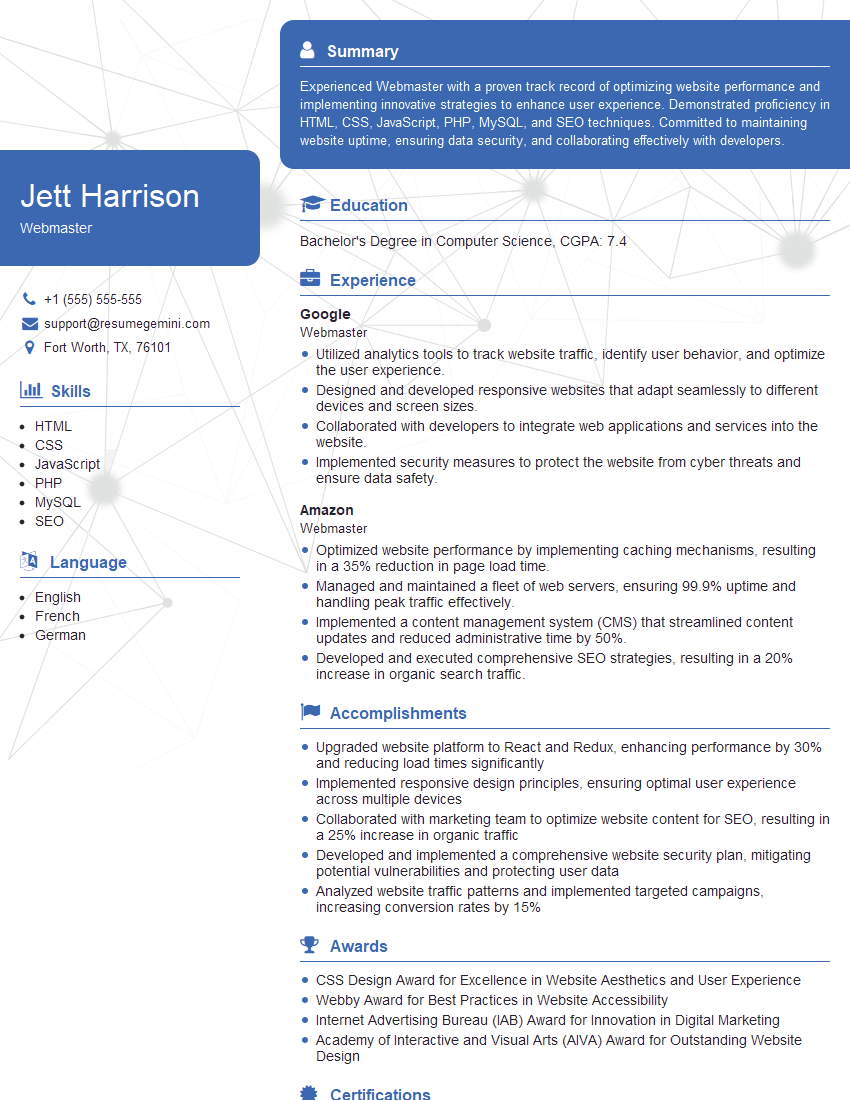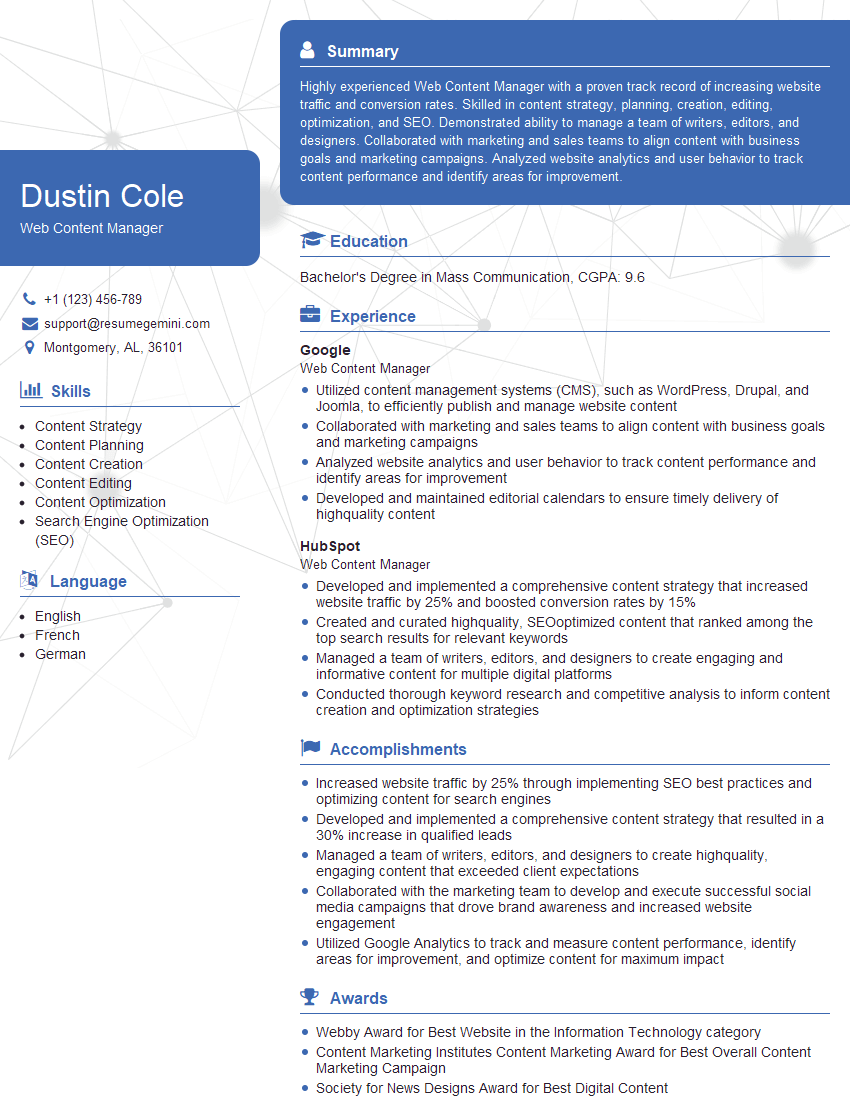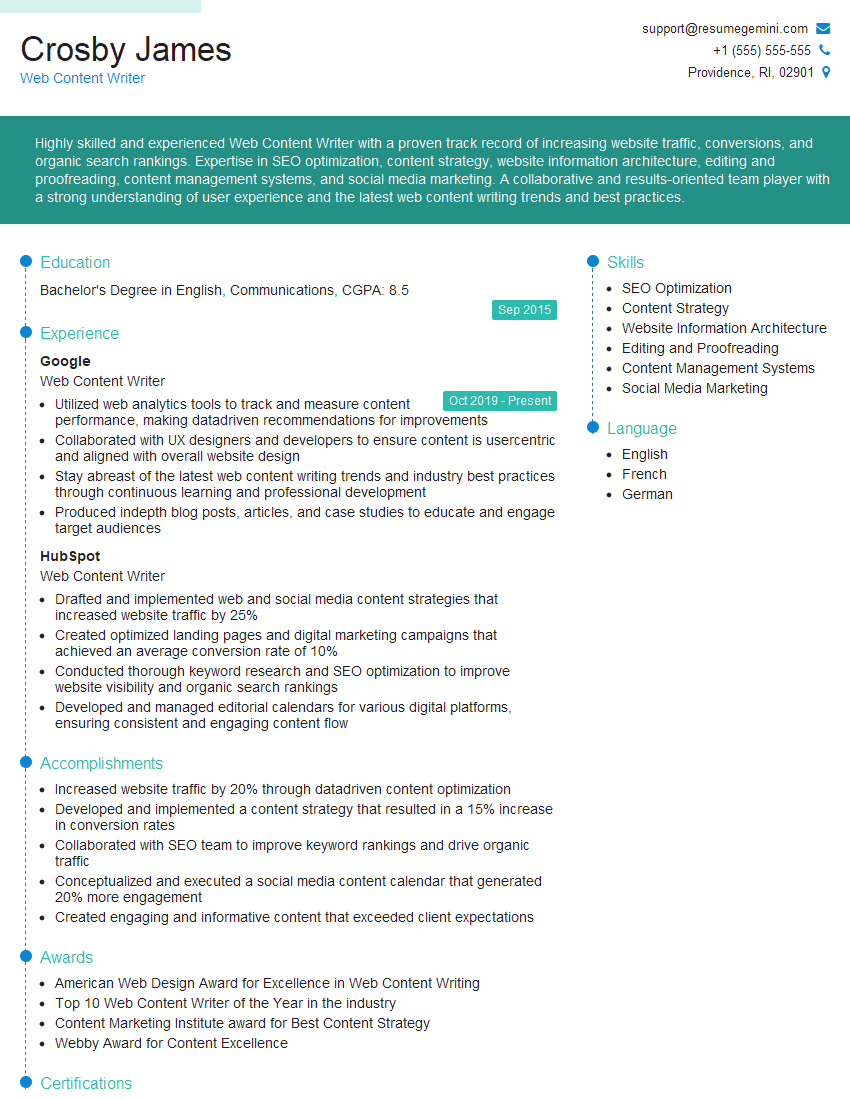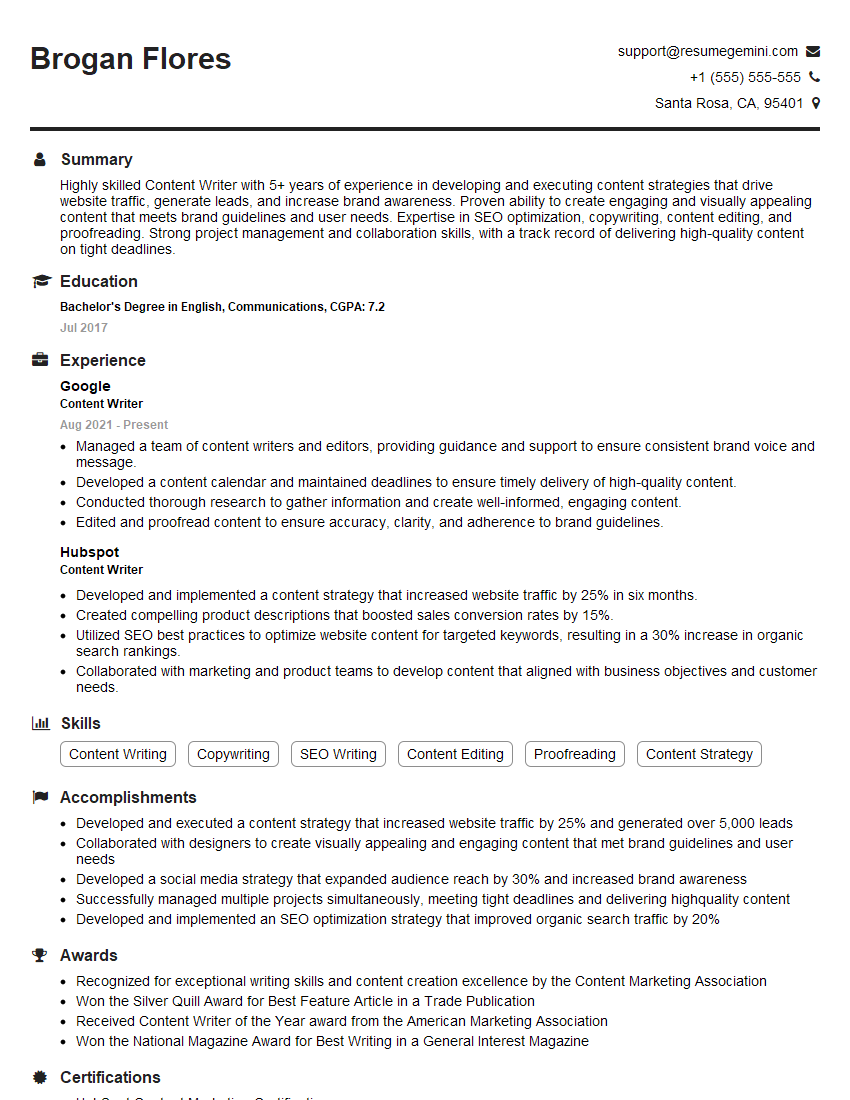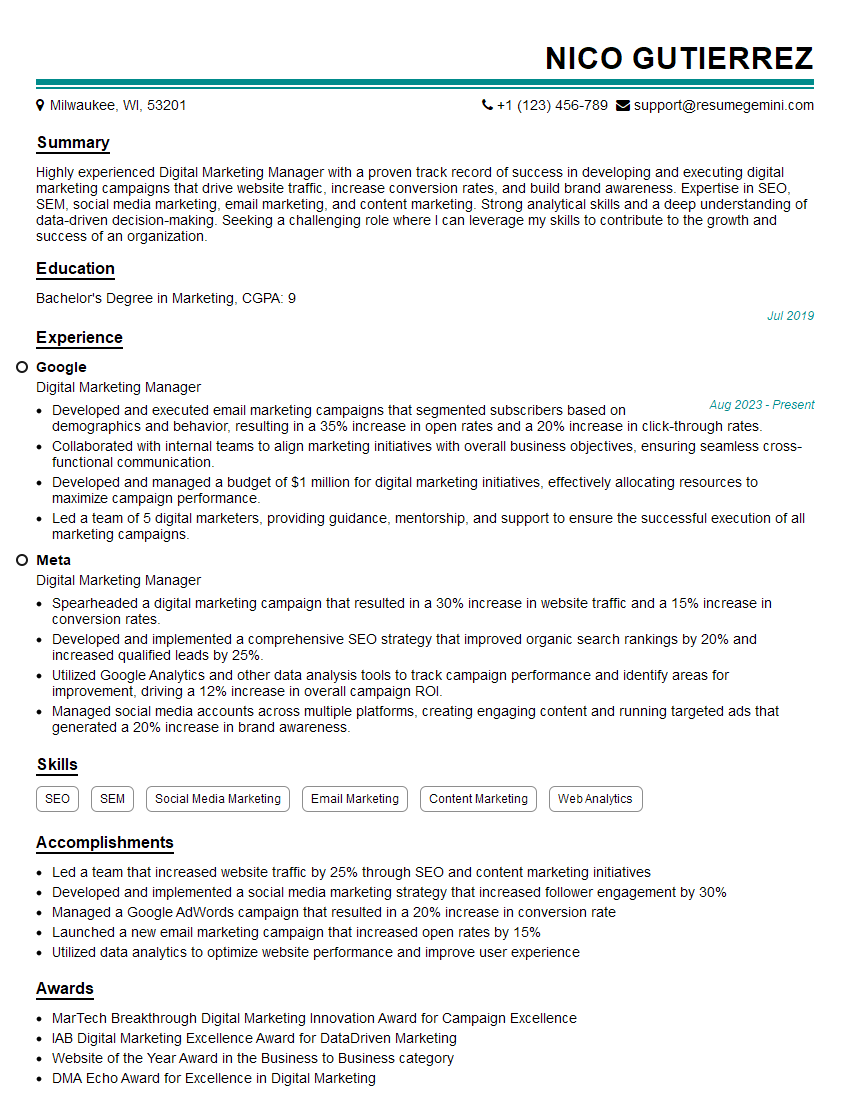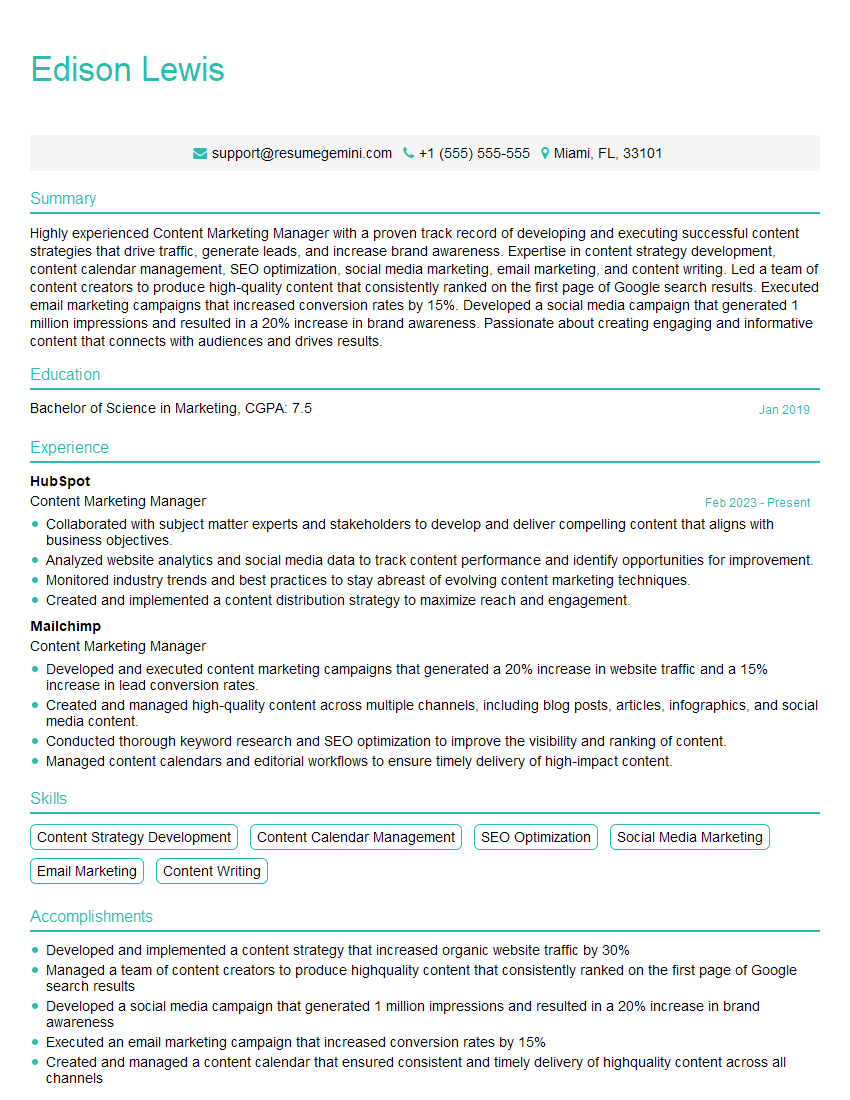Feeling uncertain about what to expect in your upcoming interview? We’ve got you covered! This blog highlights the most important Website Content Management and SEO interview questions and provides actionable advice to help you stand out as the ideal candidate. Let’s pave the way for your success.
Questions Asked in Website Content Management and SEO Interview
Q 1. Explain the difference between on-page and off-page SEO.
On-page and off-page SEO are two distinct but interconnected strategies for improving a website’s search engine ranking. Think of it like this: on-page SEO is what you control directly on your website, while off-page SEO is what others do to promote your site.
- On-page SEO involves optimizing elements within your website, such as website content, meta descriptions, title tags, header tags (H1-H6), image alt text, and internal linking. For example, carefully crafting compelling title tags and meta descriptions that accurately reflect your page’s content and include relevant keywords significantly improves your chances of attracting users from search engine results pages (SERPs).
- Off-page SEO focuses on activities outside your website that influence its ranking. This includes building high-quality backlinks from reputable websites, social media marketing, and engaging in online communities relevant to your niche. A high-quality backlink from a trusted source acts like a vote of confidence for your website in the eyes of search engines, signaling that your content is valuable and authoritative.
Both are crucial; a website with excellent on-page optimization but no off-page authority will struggle to rank, just as a website with many backlinks but poorly written content will not attract and retain visitors.
Q 2. Describe your experience with different CMS platforms (e.g., WordPress, Drupal, Joomla).
I have extensive experience with several Content Management Systems (CMS), including WordPress, Drupal, and Joomla. Each has its strengths and weaknesses, making them suitable for different projects.
- WordPress: This is the most popular CMS globally, known for its user-friendly interface, extensive plugin ecosystem, and vast community support. I’ve used WordPress for numerous projects, from small blogs to large e-commerce websites, leveraging its flexibility to create custom solutions. For example, I utilized WooCommerce to build several successful online stores.
- Drupal: Drupal is a powerful and highly flexible CMS often preferred for large-scale projects requiring robust security and scalability. Its steeper learning curve demands more technical expertise, which I possess. I’ve used Drupal to build complex websites for government and educational institutions, taking advantage of its advanced features for content management and user roles.
- Joomla: Joomla sits somewhere between WordPress and Drupal in terms of complexity and features. It offers a good balance between ease of use and functionality. I’ve utilized Joomla for smaller-scale projects where the required features were more limited and WordPress’s extensive functionality wasn’t strictly necessary.
My experience extends beyond simply using these platforms. I understand their underlying architecture, allowing me to optimize them for SEO, performance, and security. I can customize themes and develop custom modules or plugins to meet specific client needs.
Q 3. How do you conduct keyword research for a website?
Keyword research is the cornerstone of any successful SEO campaign. It involves identifying the terms and phrases people use when searching for information related to your website’s content. My approach is multi-faceted:
- Brainstorming & Competitor Analysis: I start by brainstorming keywords related to the client’s business and then analyze their competitors’ keywords to identify gaps and opportunities.
- Keyword Research Tools: I leverage tools like SEMrush, Ahrefs, and Google Keyword Planner to identify relevant keywords, analyze their search volume, competition, and difficulty. I look beyond just high-volume keywords, considering long-tail keywords (more specific, longer phrases) which often have less competition and higher conversion rates.
- Search Intent Analysis: Crucially, I analyze the intent behind the keywords. Are users looking for information, products to buy, or a specific service? Understanding intent helps in creating content that directly addresses the user’s needs.
- Mapping Keywords to Content: Once I have a solid list of keywords, I map them to specific pages on the website to ensure each page targets a specific set of related terms.
For example, for a website selling handmade jewelry, I wouldn’t just target ‘jewelry’; instead, I’d explore long-tail keywords like ‘handmade silver earrings for weddings’ or ‘artisan beaded necklaces for gifts’ to better target specific customer segments.
Q 4. What are the key factors to consider when optimizing website content for search engines?
Optimizing website content for search engines involves a holistic approach, encompassing several key factors:
- Keyword Optimization: Strategically incorporating relevant keywords into your content, including title tags, meta descriptions, header tags, and body text, ensuring natural language and avoiding keyword stuffing.
- High-Quality Content: Creating original, valuable, engaging, and informative content that satisfies user intent. This is paramount – search engines prioritize content providing a great user experience.
- Readability & User Experience (UX): Ensuring your content is easily readable with clear headings, concise paragraphs, and a user-friendly website structure. A fast loading website with intuitive navigation is critical.
- Mobile Friendliness: Optimizing your website for mobile devices, ensuring responsive design and fast loading speeds on all screens.
- Internal Linking: Connecting relevant pages within your website through internal links to improve navigation and distribute link equity.
- Image Optimization: Using descriptive alt text for images, optimizing image file sizes to improve page load speed.
- Schema Markup: Implementing schema markup to help search engines understand your content and provide richer snippets in search results.
Ignoring any of these aspects can negatively impact your search engine rankings.
Q 5. How do you measure the success of an SEO campaign?
Measuring the success of an SEO campaign requires a multi-faceted approach, tracking various key performance indicators (KPIs) over time. I typically focus on:
- Organic Search Traffic: Monitoring the increase in website traffic from organic search results using Google Analytics.
- Keyword Rankings: Tracking the improvement in keyword rankings in search engine results pages (SERPs) using tools like SEMrush or Ahrefs.
- Conversion Rate: Measuring the percentage of visitors who complete a desired action, such as making a purchase or filling out a form. This shows if SEO efforts translate into business goals.
- Bounce Rate: Analyzing the percentage of visitors who leave the website after viewing only one page. A high bounce rate suggests issues with content relevance or UX.
- Backlink Profile: Assessing the quality and quantity of backlinks pointing to the website. A stronger backlink profile generally correlates with higher rankings.
- Domain Authority & Page Authority: Tracking changes in these metrics, which reflect the overall authority and trustworthiness of the website and individual pages.
By analyzing these KPIs regularly, we can understand what’s working, what needs improvement, and make data-driven decisions to optimize the campaign for maximum effectiveness. It’s important to remember that SEO is an ongoing process; consistent monitoring and adjustments are crucial for sustained success.
Q 6. Explain the importance of schema markup.
Schema markup, also known as structured data, is code added to your website’s HTML to provide search engines with more context about your content. It’s like providing a detailed instruction manual to search engines, helping them understand the type of content on your pages – for example, whether it’s a product, article, recipe, or event.
The benefits are significant:
- Rich Snippets: Schema markup can lead to rich snippets in search results, making your listings more visually appealing and clickable, thus increasing click-through rates (CTRs).
- Improved Search Engine Understanding: By clearly defining the structure and meaning of your content, you improve the chances of accurate indexing and ranking.
- Enhanced User Experience: Rich snippets provide users with more information directly in search results, potentially reducing the need to click through to your website.
For example, adding schema markup to a product page can lead to a rich snippet displaying the product’s name, price, rating, and image directly in the search results. This makes your product listing stand out from the competition.
Implementing schema markup requires understanding different schema types and using tools like Google’s Structured Data Testing Tool to validate your implementation. It’s a valuable investment that pays off in improved search visibility and user engagement.
Q 7. What are some common SEO mistakes to avoid?
Many common SEO mistakes can significantly hinder a website’s ranking. Here are some critical ones to avoid:
- Keyword Stuffing: Overusing keywords in an unnatural way to manipulate search engines; this is detrimental and can lead to penalties.
- Ignoring Mobile Optimization: Failing to ensure your website is responsive and loads quickly on mobile devices, as Google prioritizes mobile-first indexing.
- Neglecting Content Quality: Publishing thin, low-quality, or duplicate content. Google favors unique, high-value content that satisfies user needs.
- Building Low-Quality Backlinks: Acquiring backlinks from spammy or irrelevant websites can harm your rankings.
- Ignoring Technical SEO: Overlooking crucial technical aspects like website speed, sitemap submission, and robots.txt file optimization.
- Lack of Consistent Monitoring & Analysis: Failing to track and analyze key SEO metrics to identify areas for improvement.
- Ignoring User Experience (UX): Creating a confusing or difficult-to-navigate website that frustrates users and increases bounce rates.
Avoiding these mistakes ensures that your SEO efforts are effective and sustainable, leading to improved search rankings and increased organic traffic.
Q 8. How do you handle duplicate content issues?
Duplicate content is a significant SEO issue where search engines find substantially similar content across multiple URLs. This confuses the engine, leading to lower rankings or even penalties. Handling it requires a strategic approach focusing on identifying, consolidating, and optimizing existing content.
- Canonicalization: This is the most effective solution. Using the
<link rel="canonical">tag, you specify the preferred version of a page. For example, if you have a product page accessible via bothexample.com/product-1andexample.com/product-1?aff=123, the canonical tag on the latter would point to the former, telling Google to consider the first URL the primary version. - 301 Redirects: If you have completely outdated or redundant pages, use a 301 redirect to point them to the updated, canonical version. This preserves link juice and user experience.
- Content Consolidation: If you have multiple pages with similar content, merge the best aspects into one comprehensive piece. Ensure all relevant keywords are addressed and the content is unique and valuable.
- Content Optimization: Rather than simply deleting duplicate content, rewrite it to be unique, focusing on different angles or adding fresh insights. This ensures you’re providing value to users and search engines.
For example, I once worked with a client who had numerous variations of product descriptions across multiple e-commerce platforms. Implementing canonical tags and consolidating product descriptions onto a single, optimized listing resulted in a significant improvement in organic search rankings.
Q 9. Describe your experience with Google Analytics and Search Console.
Google Analytics and Search Console are indispensable tools for monitoring website performance and SEO health. I’ve used both extensively throughout my career to identify areas for improvement and track the success of SEO strategies.
- Google Analytics: I leverage Google Analytics to analyze website traffic, user behavior, conversion rates, and more. This includes setting up custom reports to track specific goals, identifying popular pages, and understanding user demographics. I regularly monitor key metrics like bounce rate, time on page, and conversion rates to assess the effectiveness of content and identify areas needing optimization.
- Google Search Console: I use Search Console to monitor how Google sees my website. This includes checking for crawl errors, identifying indexation issues, analyzing keyword rankings, and reviewing sitemap submissions. I actively use Search Console to identify and address any technical SEO problems that might hinder performance. For instance, it helps diagnose issues like broken links, improper structured data, or slow page loading speed that impact search rankings.
In a recent project, I used both tools in conjunction to diagnose a sudden drop in organic traffic. Google Analytics revealed a spike in bounce rate, suggesting an issue with user experience. Further investigation in Search Console uncovered a significant number of 404 errors, which we quickly addressed through proper redirects, resulting in a traffic recovery.
Q 10. What is the role of internal linking in SEO?
Internal linking is crucial for SEO. It’s like building a roadmap within your website, guiding both users and search engines through your content. It improves navigation, distributes link equity (ranking power), and strengthens topical relevance.
- Improved User Experience: Well-structured internal links help users navigate your website easily, reducing bounce rates and increasing time on site.
- Link Equity Distribution: Internal links pass ‘link juice’—a ranking signal—from one page to another. Linking authoritative pages to newer or less-ranked pages helps boost their ranking potential.
- Topical Relevance: Linking related pages reinforces the topical authority of your website, helping search engines understand the focus and expertise of your site.
Imagine your website as a city. External links are the highways leading to your city, while internal links are the roads connecting different neighborhoods. A well-planned internal linking strategy ensures that all areas of your website are accessible and well-connected.
Q 11. How do you stay updated with the latest SEO trends and algorithm changes?
Staying up-to-date with SEO trends is paramount. I utilize various methods to ensure I’m knowledgeable about algorithm updates and best practices.
- Following Industry News and Blogs: I regularly read authoritative SEO blogs, publications, and newsletters, such as Search Engine Journal, Moz, and Ahrefs blog.
- Attending Webinars and Conferences: Participating in industry events helps me learn directly from experts and network with other professionals.
- Monitoring Google’s Announcements: Keeping an eye on Google’s official announcements and webmaster blog is critical for understanding major algorithm updates and changes.
- Experimentation and Data Analysis: I regularly conduct A/B testing on different SEO strategies to measure their effectiveness and adapt my approach accordingly.
For example, the recent emphasis on Core Web Vitals highlights the importance of user experience. By staying informed, I can prioritize site speed and user-friendliness to improve my clients’ search rankings.
Q 12. Explain the concept of link building and its importance.
Link building is the process of acquiring backlinks—links from other websites to your website. It’s a cornerstone of off-page SEO, significantly influencing your website’s authority and search engine rankings.
- Improved Ranking Potential: Search engines view backlinks as votes of confidence. High-quality backlinks from reputable websites signal to search engines that your content is valuable and authoritative, leading to higher rankings.
- Increased Referral Traffic: Backlinks drive traffic from other websites to your site. This brings in new users and potential customers.
- Enhanced Brand Awareness: Links from authoritative websites can significantly improve your brand’s visibility and recognition.
However, it’s crucial to focus on quality over quantity. Low-quality backlinks from spammy sites can harm your rankings. I focus on earning links through content marketing, guest blogging, and building relationships with other websites in my niche. For example, creating high-quality, shareable content naturally attracts links from other websites, leading to a sustainable and impactful link-building strategy.
Q 13. What is your experience with content audits?
A content audit is a systematic analysis of your website’s existing content to identify strengths, weaknesses, and areas for improvement. This is vital for optimizing your content strategy and enhancing SEO performance. I have extensive experience conducting thorough content audits using a structured approach.
- Inventory Creation: First, I create a comprehensive inventory of all existing website pages, including URLs, titles, meta descriptions, and publication dates.
- Content Analysis: I then analyze the content itself, evaluating its quality, relevance, keyword targeting, and overall effectiveness. I assess readability, completeness, and accuracy.
- SEO Performance Evaluation: I evaluate each page’s SEO performance, considering metrics such as organic traffic, keyword rankings, and backlinks.
- Gap Analysis: Finally, I identify gaps in the content strategy, focusing on missing topics, outdated information, and opportunities for improvement.
A recent content audit for a client revealed several underperforming pages with outdated information and poor keyword targeting. Based on the audit findings, we updated existing content, created new pages to address identified gaps, and implemented a revised keyword strategy, resulting in improved organic visibility.
Q 14. How do you ensure website content is both SEO-friendly and user-friendly?
Balancing SEO-friendliness and user-friendliness is essential for successful website content. SEO focuses on optimizing content for search engines, while user-friendliness emphasizes creating content that is engaging and easy to consume for your target audience. The two aren’t mutually exclusive; they should complement each other.
- Keyword Research & Contextualization: I conduct thorough keyword research to identify relevant terms, but I integrate them naturally within the text. Keyword stuffing harms user experience.
- High-Quality, Engaging Content: I prioritize creating high-quality, well-written, and engaging content that addresses user needs and provides value. This keeps users on the site longer and encourages interactions.
- Clear Structure & Readability: Using headings, subheadings, bullet points, and short paragraphs improves readability, benefiting both users and search engines. Well-formatted content is easily scanned and understood.
- Fast Loading Speed: Optimizing images and minimizing code ensures quick loading times, improving user experience and boosting SEO.
- Mobile Responsiveness: Ensuring the website is mobile-friendly is crucial for both user experience and SEO, as Google prioritizes mobile-first indexing.
I often use tools like Google’s PageSpeed Insights to assess site speed and identify areas for improvement. A well-structured, easy-to-read, and fast-loading website benefits both users and search engine crawlers, maximizing search visibility and user engagement. For example, in a recent project, redesigning a client’s website with a focus on user experience, including improved navigation and mobile responsiveness, led to both a significant rise in organic traffic and a substantial increase in user engagement.
Q 15. What is your understanding of Core Web Vitals?
Core Web Vitals are a set of metrics used by Google to evaluate the user experience of a website. They focus on three key aspects: Largest Contentful Paint (LCP), measuring loading speed; Cumulative Layout Shift (CLS), assessing visual stability; and First Input Delay (FID), reflecting interactivity. Think of it like this: LCP is how quickly the main content appears, CLS is how much the page jumps around unexpectedly while loading, and FID is how quickly the page responds to your clicks and taps.
Good Core Web Vitals scores are crucial for SEO because Google uses them as a ranking factor. A slow, unstable, or unresponsive website will likely rank lower than a well-optimized one. To improve Core Web Vitals, you might optimize images, leverage browser caching, use a Content Delivery Network (CDN), and minimize render-blocking resources. Tools like Google PageSpeed Insights can help diagnose problems and suggest solutions.
Career Expert Tips:
- Ace those interviews! Prepare effectively by reviewing the Top 50 Most Common Interview Questions on ResumeGemini.
- Navigate your job search with confidence! Explore a wide range of Career Tips on ResumeGemini. Learn about common challenges and recommendations to overcome them.
- Craft the perfect resume! Master the Art of Resume Writing with ResumeGemini’s guide. Showcase your unique qualifications and achievements effectively.
- Don’t miss out on holiday savings! Build your dream resume with ResumeGemini’s ATS optimized templates.
Q 16. Describe your process for creating a content calendar.
Creating a content calendar involves a strategic process. First, I conduct thorough keyword research to identify relevant topics that align with business goals and audience interests. I use tools like SEMrush or Ahrefs to uncover keywords with high search volume and low competition. Then, I brainstorm content formats, such as blog posts, infographics, videos, or social media updates, determining which best suits each topic.
Next, I develop a content strategy, outlining a publishing schedule and assigning responsibilities. This schedule is often organized chronologically, ensuring content aligns with seasonal trends or marketing campaigns. For example, you might plan holiday-themed content well in advance or create a series of related posts to improve topical authority. Finally, I track performance metrics like engagement and conversions to refine the calendar and optimize future content planning. This iterative process ensures continuous improvement and relevance.
Q 17. Explain the difference between black hat and white hat SEO techniques.
White hat SEO refers to ethical and sustainable SEO practices that comply with search engine guidelines. It focuses on creating high-quality content, building high-authority backlinks, and optimizing websites for users and search engines. Think of it as playing the game fairly.
Black hat SEO, on the other hand, involves manipulative tactics designed to trick search engines into ranking a website higher. Examples include keyword stuffing, cloaking (showing different content to users and search engines), and buying low-quality backlinks. These methods are risky because they can lead to penalties, including a significant drop in rankings or even removal from search results. It’s like cheating at the game.
Choosing white hat SEO is crucial for long-term success. While black hat techniques might offer short-term gains, they ultimately harm your website’s reputation and sustainability. White hat techniques, while slower, build lasting value.
Q 18. How do you identify and resolve website technical SEO issues?
Identifying and resolving technical SEO issues requires a systematic approach. I start by using tools like Google Search Console and Screaming Frog to crawl the website and identify potential problems. This might include broken links, crawl errors, slow page speed, duplicate content, or mobile-friendliness issues.
Once identified, I prioritize issues based on their impact on SEO and user experience. For example, fixing broken links is usually a high priority as it improves user experience and reduces crawl errors. I document all issues, implement solutions, and then use Google Search Console to monitor the impact of the changes. This iterative process of identification, prioritization, resolution, and monitoring is essential for maintaining a healthy website.
For example, if Screaming Frog reveals a large number of 404 errors (broken links), I’d create a spreadsheet to categorize and then redirect those links to appropriate pages. This ensures that users and search engines don’t encounter broken links, improving the user experience and the site’s crawlability.
Q 19. What is your experience with A/B testing for website content?
A/B testing is a crucial part of content optimization. It involves creating two versions of a webpage (A and B) with slight variations, such as different headlines, call-to-actions, or image placements. These variations are then shown to different segments of users to determine which performs better based on specific metrics, such as click-through rates or conversion rates.
My experience includes setting up and analyzing A/B tests using tools like Google Optimize or Optimizely. I define clear hypotheses, identify key performance indicators (KPIs), and ensure statistically significant sample sizes to obtain reliable results. The data collected is then used to improve the website’s content and overall effectiveness. For example, we might A/B test two different versions of a landing page – one with a concise headline and another with a more detailed one – to see which generates a higher conversion rate.
Q 20. How do you prioritize SEO tasks and manage your time effectively?
Prioritizing SEO tasks and managing time effectively requires a well-defined strategy. I typically start by creating a prioritized list of tasks based on their impact on SEO and business goals. This involves assigning each task a level of importance and urgency using a matrix like Eisenhower’s Urgent/Important matrix. High-impact tasks, like optimizing core pages or fixing significant technical issues, are tackled first.
I use project management tools, like Trello or Asana, to organize and track progress. These tools allow me to break down large tasks into smaller, manageable ones. Time blocking techniques and regular progress reviews help ensure that I stay on schedule and maintain focus. Regular reporting and communication with stakeholders ensures everyone is informed about progress and any potential roadblocks. This ensures efficient resource allocation and optimal use of my time.
Q 21. Describe your experience with different SEO tools (e.g., SEMrush, Ahrefs, Moz).
I have extensive experience using various SEO tools, including SEMrush, Ahrefs, and Moz. SEMrush provides comprehensive keyword research capabilities, competitive analysis tools, and website audit functionalities. I use it regularly for identifying relevant keywords, analyzing competitor strategies, and tracking website performance.
Ahrefs is another powerful tool known for its backlink analysis features. I utilize Ahrefs to identify high-quality backlinks, assess the authority of competing websites, and track the growth of my client’s backlink profiles. Moz offers a suite of tools, including keyword research, rank tracking, and site audit features. I find Moz particularly useful for monitoring keyword rankings and identifying areas for improvement in on-page optimization.
The choice of tool often depends on the specific needs of the project. For example, for a detailed competitive analysis, I might heavily rely on SEMrush, while for in-depth backlink analysis, Ahrefs would be my preferred choice.
Q 22. How do you work with other teams (e.g., development, marketing) to achieve SEO goals?
Collaboration is key to successful SEO. I foster strong relationships with development and marketing teams by establishing clear communication channels and shared goals. For instance, I’d work with the development team to ensure the website is technically sound for SEO (e.g., fast loading speed, proper schema markup), providing them with specific technical requirements. With marketing, I’d ensure SEO considerations are incorporated into content strategies, keyword research is aligned with marketing campaigns, and that SEO data is integrated into marketing reports. This collaborative approach involves regular meetings, shared project management tools, and a clear understanding of each team’s role and responsibilities. For example, I might provide the marketing team with a monthly SEO performance report highlighting which content pieces are performing well and why, and then discuss what type of content needs to be produced to target new keywords.
Q 23. What are some best practices for mobile SEO?
Mobile SEO is crucial as most searches now originate from mobile devices. Best practices include: ensuring your website is responsive (adapts seamlessly to different screen sizes), optimizing page speed for mobile, using mobile-friendly content (easy to read and navigate on smaller screens), and building a mobile-first index (Google primarily indexes the mobile version of your site). I would also emphasize local SEO for mobile searches, ensuring Google My Business is optimized and that businesses are easy to find on mobile maps. Imagine a pizza restaurant – if their mobile site is slow, hard to navigate, or their location isn’t easily visible on Google Maps, they’ll lose customers to competitors with a better mobile experience.
Q 24. How do you adapt your SEO strategy for different industries or niches?
Adapting SEO strategy requires understanding the unique characteristics of each industry. For example, the keywords and competitive landscape for a luxury car brand will differ drastically from those of a local bakery. In the luxury car industry, focusing on long-tail keywords and building high-authority content through partnerships with automotive publications is critical. For the bakery, local SEO, focusing on proximity-based keywords, and building online reviews through platforms like Google My Business are more effective. A key element is competitor analysis – understanding their strategies and identifying opportunities to differentiate your approach. I always start by deeply researching the industry, identifying relevant keywords, and analyzing the competitive landscape before tailoring my strategy.
Q 25. How do you handle negative SEO attacks?
Negative SEO attacks, like unnatural link building or keyword stuffing from competitors, can severely impact rankings. My approach is multi-faceted: proactive monitoring using SEO tools to detect unusual patterns in backlinks and rankings; identifying and disavowing harmful backlinks through Google Search Console; creating high-quality, original content to naturally build authority; and focusing on overall website health to make it resilient to attacks. Think of it like securing your house; you need a strong foundation and regular security checks to protect it from intruders. Regular site audits, vigilant link monitoring, and a strong content strategy are vital to mitigating these attacks.
Q 26. Describe your experience with international SEO and localization.
I have extensive experience in international SEO and localization. This involves adapting content for different languages and cultures, considering regional search patterns, and optimizing for different country-specific Top-Level Domains (TLDs). For instance, translating website content isn’t enough; cultural nuances must be considered, and content should be tailored to resonate with the target audience. Technical aspects also play a vital role – hreflang tags are essential to tell Google which language and region a page is targeting. I’ve successfully implemented international SEO strategies for clients across various regions, resulting in increased organic traffic and improved conversion rates in global markets. I always work closely with translation teams to ensure accurate and culturally relevant content.
Q 27. How would you approach increasing organic traffic for a specific landing page?
Increasing organic traffic to a specific landing page requires a targeted approach. First, keyword research is crucial – identifying relevant keywords with high search volume and low competition. Then, on-page optimization is key: optimizing title tags, meta descriptions, and header tags with the target keywords; ensuring fast loading speeds; creating high-quality, engaging content that directly addresses the user’s search intent. Off-page optimization includes building high-quality backlinks to the landing page through content marketing, guest blogging, and outreach. I’d also monitor the page’s performance using Google Analytics and Search Console, regularly adjusting the strategy based on the data. This iterative process requires constant monitoring and adjustments.
Q 28. What is your understanding of the importance of content quality in SEO?
Content quality is paramount in SEO. Google’s algorithms prioritize high-quality, engaging, and informative content that satisfies user search intent. Low-quality, thin content is easily penalized. High-quality content builds trust and authority, attracting backlinks and improving rankings. I would measure content quality using several factors, including originality, readability, comprehensiveness, accuracy and relevance to target keywords and audience needs. Imagine two articles on ‘best hiking boots’: one is short, generic, and filled with affiliate links; the other is detailed, reviews multiple brands, provides expert insights, and includes stunning photos. The second will perform far better, establishing the site as a trusted resource.
Key Topics to Learn for Website Content Management and SEO Interview
- Website Content Strategy: Understanding the importance of defining clear goals, target audiences, and content pillars for a website.
- Content Creation and Optimization: Writing compelling and SEO-friendly content, incorporating keywords naturally, and optimizing for readability.
- Content Management Systems (CMS): Familiarity with popular CMS platforms like WordPress, Drupal, or Joomla; understanding their functionalities and limitations.
- On-Page SEO: Implementing techniques like keyword research, title tag optimization, meta description writing, header structure (H1-H6), and internal linking.
- Off-Page SEO: Building high-quality backlinks through strategies such as guest posting, social media promotion, and outreach.
- Technical SEO: Understanding website architecture, site speed optimization, mobile-friendliness, schema markup, and XML sitemaps.
- SEO Analytics and Reporting: Using tools like Google Analytics and Google Search Console to track website performance, identify areas for improvement, and demonstrate ROI.
- Content Scheduling and Workflow: Managing content calendars, editorial workflows, and collaborating effectively with teams.
- Search Engine Algorithms and Updates: Staying up-to-date with the latest algorithm changes and adapting strategies accordingly.
- Problem-Solving in Content Management and SEO: Troubleshooting common issues, such as low organic traffic, poor website performance, or content ranking challenges.
Next Steps
Mastering Website Content Management and SEO is crucial for a successful career in digital marketing, offering high demand and excellent growth opportunities. A strong understanding of these areas makes you a valuable asset to any organization. To enhance your job prospects, focus on creating a compelling and ATS-friendly resume that highlights your skills and experience. ResumeGemini is a trusted resource that can help you build a professional and impactful resume tailored to your unique qualifications. We provide examples of resumes specifically crafted for Website Content Management and SEO roles to guide you in creating yours.
Explore more articles
Users Rating of Our Blogs
Share Your Experience
We value your feedback! Please rate our content and share your thoughts (optional).
What Readers Say About Our Blog
These apartments are so amazing, posting them online would break the algorithm.
https://bit.ly/Lovely2BedsApartmentHudsonYards
Reach out at [email protected] and let’s get started!
Take a look at this stunning 2-bedroom apartment perfectly situated NYC’s coveted Hudson Yards!
https://bit.ly/Lovely2BedsApartmentHudsonYards
Live Rent Free!
https://bit.ly/LiveRentFREE
Interesting Article, I liked the depth of knowledge you’ve shared.
Helpful, thanks for sharing.
Hi, I represent a social media marketing agency and liked your blog
Hi, I represent an SEO company that specialises in getting you AI citations and higher rankings on Google. I’d like to offer you a 100% free SEO audit for your website. Would you be interested?
